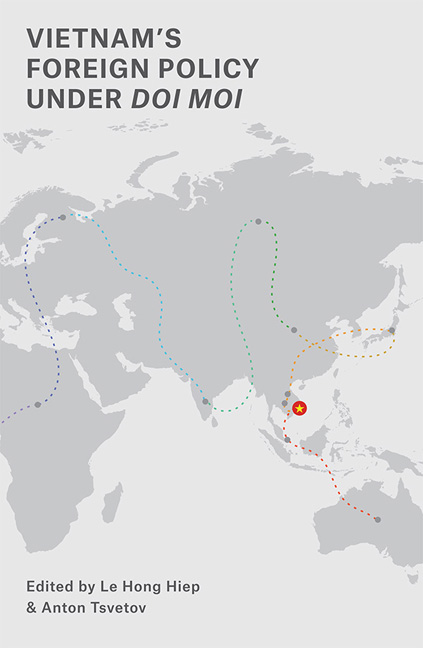Book contents
- Frontmatter
- Contents
- List of Tables
- List of Figures
- List of Abbreviations
- Acknowledgements
- About the Contributors
- PART I ANALYTICAL AND HISTORICAL FRAMEWORK
- PART II BILATERAL RELATIONSHIPS
- 3 The Evolution of Strategic Trust in Vietnam–U.S. Relations
- 4 The 2014 Oil Rig Crisis and its Implications for Vietnam–China Relations
- 5 Vietnam–Japan Relations: Moving beyond Economic Cooperation?
- 6 The Reinvigoration of India–Vietnam Partnership under Prime Minister Modi
- 7 Vietnam–Russia Relations: Glorious Past, Uncertain Future
- 8 Vietnam's Foreign Policy Towards its Smaller Neighbours
- 9 Vietnam's Decision to Join ASEAN: The South China Sea Disputes Connection
- PART III MAJOR FOREIGN POLICY ISSUES
- Index
3 - The Evolution of Strategic Trust in Vietnam–U.S. Relations
from PART II - BILATERAL RELATIONSHIPS
Published online by Cambridge University Press: 04 July 2018
- Frontmatter
- Contents
- List of Tables
- List of Figures
- List of Abbreviations
- Acknowledgements
- About the Contributors
- PART I ANALYTICAL AND HISTORICAL FRAMEWORK
- PART II BILATERAL RELATIONSHIPS
- 3 The Evolution of Strategic Trust in Vietnam–U.S. Relations
- 4 The 2014 Oil Rig Crisis and its Implications for Vietnam–China Relations
- 5 Vietnam–Japan Relations: Moving beyond Economic Cooperation?
- 6 The Reinvigoration of India–Vietnam Partnership under Prime Minister Modi
- 7 Vietnam–Russia Relations: Glorious Past, Uncertain Future
- 8 Vietnam's Foreign Policy Towards its Smaller Neighbours
- 9 Vietnam's Decision to Join ASEAN: The South China Sea Disputes Connection
- PART III MAJOR FOREIGN POLICY ISSUES
- Index
Summary
The history of Vietnam–U.S. relations since the end of the Vietnam War in 1975 is a long and oftentimes delicate journey of forging mutual trust, where none existed before. The end of the war ushered in a period of renewed hostility between the two countries, and prompted Washington to mobilize extensive international embargoes against Hanoi, especially after the latter sent its troops into Cambodia in late 1978. While some attempts to normalize bilateral relations were made within the first few years after the war ended, it was not until the start of Doi Moi in 1986 that Vietnamese leaders became more attuned to the impetus of resuming relations with its former enemy and adapting Vietnam's foreign policy to the new demands of its economic reforms.
In How Enemies Become Friends: The Sources of Stable Peace, Charles Kupchan (2010) examines the process and conditions necessary for two states — irrespective of power dynamics — to make peace with one another and forge a relationship that can be considered institutionalized. Accordingly, while strategic necessity is needed to trigger either side to seek out the other, states must come to a point at which they view their bargaining as no longer taking place under “conditions of suspicion and competition”. In other words, “mutual confidence and trust” allow two states to “minimize the hindrances of uncertainty”. By the same token, states which cannot establish a degree of presumption about the other side's “benign character” do not succeed in reconciling and becoming friends (Kupchan 2010, pp. 389–91).
Given the history of their relations, the creation of the level of mutual trust necessary to rebuild ties was especially challenging, yet critical, for Hanoi and Washington. Despite the cooperation between Ho Chi Minh's revolutionary forces and the United States against the Japanese in the final months of World War II, interactions between the two sides turned precarious at the onset of the Cold War and quickly descended into intense hostility in subsequent decades as they found themselves on opposing sides of the ideological spectrum. As such, building — and reinforcing — trust becomes a prerequisite for not only the normalization but also the strengthening of their relationship.
- Type
- Chapter
- Information
- Vietnam's Foreign Policy under Doi Moi , pp. 47 - 71Publisher: ISEAS–Yusof Ishak InstitutePrint publication year: 2018

